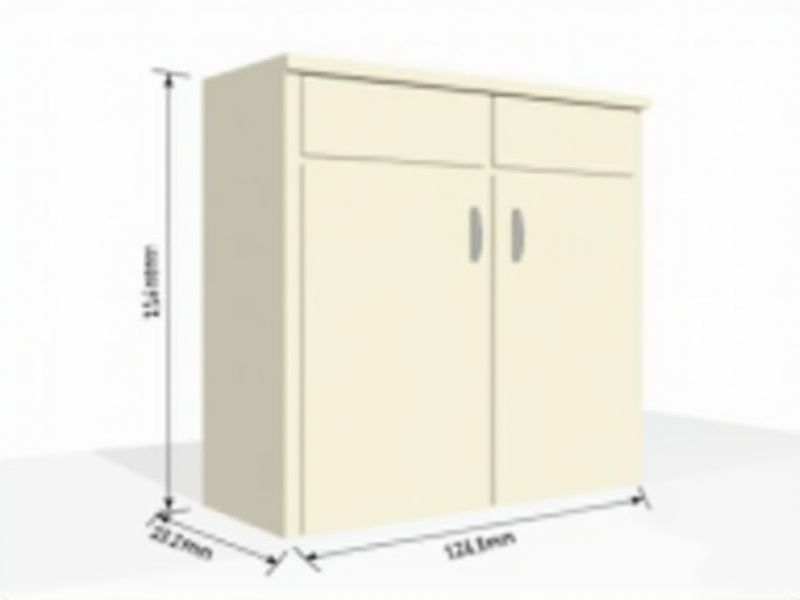
When planning a kitchen or storage area, knowing the standard dimensions of base cabinets helps ensure a smooth installation process. Typically, base cabinets are 24 inches deep and 34.5 inches high without countertops, which allows them to accommodate most appliances and provide comfortable workspace height. The widths of base cabinets can vary, commonly ranging from 9 to 48 inches in 3-inch increments to fit various layouts and needs. These standard sizes help homeowners and contractors plan efficient, functional spaces with minimal customization required.
Width Options: 9", 12", 18", 24", 30", 36
Base cabinets typically come in standard widths of 9 inches, 12 inches, 18 inches, 24 inches, 30 inches, and 36 inches, allowing you to customize kitchen layouts effectively. These varying dimensions cater to different storage needs and kitchen designs, ensuring functionality in tight spaces or expansive areas. When selecting your base cabinet, consider the specific measurements of your kitchen to optimize storage and flow. Each width option supports a variety of applications, from maximizing drawer space to accommodating specialized kitchen equipment.
Standard Depth: 24
The standard depth for base cabinets is typically 24 inches, providing ample space for storage and countertop usage. This depth accommodates most kitchen appliances, ensuring a functional layout for your cooking and food preparation needs. Base cabinets are often designed with a height of 34.5 inches, allowing them to support standard countertop heights of 36 inches when combined with a countertop thickness of 1.5 inches. Choosing cabinets with these dimensions ensures a seamless integration into your kitchen design while maximizing accessibility and efficiency.
Standard Height: 34.5
Base cabinets typically adhere to a standard height of 34.5 inches, providing an optimal working height for most users. This measurement excludes the countertop, which generally adds another 1.5 to 2 inches, resulting in a combined height of 36 to 36.5 inches. Ensuring that your base cabinets meet this height can greatly enhance your kitchen's ergonomics and functionality. When planning your kitchen layout, consider how this standard height affects both appliance integration and overall ease of use.
Toe Kick Height: 4.5
The standard toe kick height for base cabinets is typically 4.5 inches, providing ergonomic benefits that promote comfort in kitchen tasks. This specific height allows for optimal foot clearance while standing, enhancing accessibility to the countertop. A toe kick space of 3 inches deep is also common, supporting your stance while preventing damage to the cabinet's structure. Considering these measurements ensures that your kitchen design remains both functional and aesthetically pleasing.
Adjustable Shelves
Adjustable shelves in base cabinets offer unparalleled flexibility, allowing you to customize storage according to your needs. Typically crafted from durable materials, these shelves can support varying weights, accommodating items up to 50 pounds each. By utilizing a system of brackets or pin holes, you can easily reposition shelves every 1 to 2 inches, ensuring optimal organization space for your kitchen essentials. Your choice of adjustable shelves can enhance not only functionality but also the overall aesthetic of your cabinetry.
Overlay Or Inset Doors
Base cabinets typically feature either overlay or inset doors, each offering distinct aesthetic and functional qualities. Overlay doors cover the cabinet frame entirely, resulting in a modern look with minimal visible structure, while inset doors are set within the frame, providing a classic appeal with exposed edges. Choosing the right option can significantly influence the overall design; for example, overlay doors are often favored in contemporary kitchens, accounting for approximately 75% of new constructions, whereas inset doors appeal to around 25% of homeowners seeking a traditional style. Your selection may also affect the cost, with inset doors usually requiring more precise craftsmanship and materials, leading to higher pricing by about 20%.
Material Choices: Plywood Or Mdf
When selecting a base cabinet, consider the material choices of plywood and MDF, as these can significantly impact durability and performance. Plywood, made from layers of wood veneer, offers higher strength and resistance to moisture, making it ideal for kitchen and bathroom environments. In contrast, MDF (medium-density fiberboard) provides a smoother surface for painting and is more cost-effective, but it may not withstand heavy moisture exposure as well as plywood. Opt for plywood if longevity and resilience are priorities, while MDF can be suitable for projects where budget constraints are more significant.
Face Frame Or Frameless Design
The base cabinet design can be categorized into two primary types: face frame and frameless. Face frame cabinets, typically constructed from a sturdy wooden frame, offer added strength and a classic aesthetic, while allowing for custom doors and drawer sizes, usually measuring around 24 inches deep. In contrast, frameless cabinets, often seen in modern designs, provide more interior space and a sleek look, with a standard depth of 24 inches as well. Your choice between these designs can significantly impact storage efficiency and overall kitchen appearance.
Soft-Close Hinges Or Drawers
Standard base cabinets now often incorporate soft-close hinges and drawers, enhancing both functionality and aesthetics in your kitchen or bathroom. These soft-close mechanisms operate smoothly, preventing loud slamming and reducing wear on cabinet structures, which can extend their lifespan by up to 50%. Soft-close features are available in various styles, accommodating cabinet sizes from 12 to 36 inches wide, making them a versatile choice for any layout. When considering updates, focusing on these modern hardware options will significantly improve the user experience and overall feel of your spaces.
Corner Cabinet Options: Lazy Susan Or Blind Corner
When selecting a base cabinet, corner cabinet options like lazy susans and blind corners play a crucial role in maximizing space. A lazy susan features rotating shelves, allowing easy access to items in tight corners, often increasing accessibility by up to 50%. In contrast, blind corner cabinets typically utilize pull-out mechanisms or specialized shelving to store items that would otherwise be difficult to reach, expanding usable space by 30%. Understanding these options ensures that your kitchen design is both functional and efficient, enhancing your overall storage capability.
